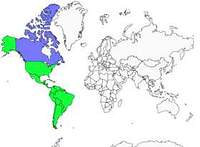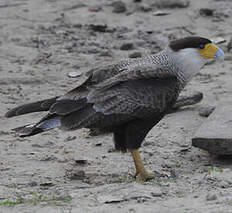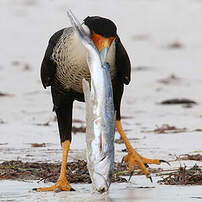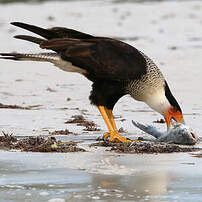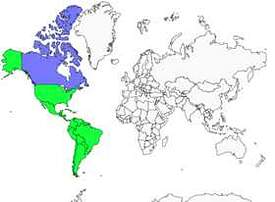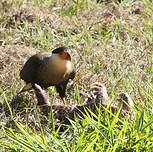Crested Caracara
Caracara plancus - Caracara huppé
Identification
The unmistakable orange-red wax that runs from the nostrils to the forehead ends in a strong gray-silver beak. The black cap covers the upper part of the cheekbones, almost horizontally sharing the black eye which has a yellow orbital ring, the tip of the cap slightly stands up when there's wind and the caracara becomes crested! The neck and throat are light gray, discontinuous and horizontal black markings mark the chest and mantle, the belly turns black. The coverings are black, the tertiary and secondary remiges present slight white markings, these vary depending on the individuals, sometimes they are completely absent. The undertail coverts are white-gray with black stripes up to the rectrices whose tip is black.
In flight the Crested Caracara shows beautiful white primaries that end in a black hand, and the undertail covert will be clearly visible as white-gray blades striped with black.
The young have the same characteristics in terms of color distribution, but the black parts of the adult are brown in the young to darken with age, the adult's orange-red wax is initially gray for the youngster. Females are larger than males.
The Northern Caracara or Caracara of the North, ssp cheriway, is very close, the most visible difference being the almost complete absence of white markings on the tertiary and secondary remiges, the bird is blacker.
Subspecific information 2 subspecies
- Caracara plancus plancus (n Bolivia to e Brazil south to Tierra del Fuego, Falkland Is.)
- Caracara plancus cheriway (s USA to n SA)
Foreign names
- Caracara huppé,
- Carancho meridional,
- carcará-de-poupa,
- Schopfkarakara,
- bóbitás karakara,
- Kuifcaracara,
- Caracara meridionale,
- tofskarakara,
- Gribbkarakara,
- karakara pásikavá,
- karančo jižní,
- Caracara,
- eteläntöyhtökarakara,
- caracarà crestat meridional,
- karakara czubata,
- dienvidu karakara,
- Обыкновенная каракара,
- ミナミカラカラ,
- 凤头巨隼,
- tofskarakara,
- 南美鳳頭卡拉鷹,
Voice song and call
Habitat
He loves open spaces or alternations of savannah and forests, meadows dotted with palms, rivers or riverbanks, waterpoints and marshes, and can be found both at sea level and at altitude: a juvenile was seen with a upland Crested Caracara at 3,800m in Bolivia! Being opportunistic, like many raptors, it can be found near pastures, crops and villages.
Behaviour character trait
Dietfeeding habits
You are not dreaming, the Crested Caracara is indeed a falconid, but we are not going to make a noble hunter out of it like a Peregrine Falcon! We are dealing with a predator in the broadest sense of the word: it's a scavenger when it can, and can be seen by the side of roads on the corpses of all kinds of animals killed by a vehicle, near herds, close to rivers looking for dead fish.
Live food is also common in its diet: just hatched turtles, iguanas, geckos, all types of insects or larvae, plundering all the nests it can find, even those of its own species! Groups of 3 to 4 caracaras have been seen attacking an egret; it approaches heronries to grab the chicks of spoonbills, herons and other ardeids. More opportunistic impossible! It may fly the flag of piracy by attacking other caracaras, raptors or pelicans to make them regurgitate their prey. When it's with vultures like the Red-headed or Black Vultures, it will also attack it to make it regurgitate its meal so it can claim it before it reaches the ground. A raptor with a strong character, dominating carcasses when there are a few vultures.Reproduction nesting
The breeding season generally takes place during the Southern Hemisphere summer from December to March in the southernmost parts of South America, but in warmer regions the Crested Caracara can breed year-round and make two nests per year.
The nest, with a diameter of 80 cm and a depth of around 30 cm, is constructed using an intermeshing of branches and twigs into all types of trees, often palm trees, and may be lined with plant fibers although this isn't systematic. Some nests have also been found on the ground. The clutch range from one to three eggs and incubation takes around thirty days. The chicks wait for three months before being able to fly.Geographic range
The entire South American continent, from the tip of Patagonia to the Brazilian Matto Grosso and the southern half of Peru, Argentina, Chile, Uruguay, Bolivia, and Paraguay, is home to the Crested Caracara (Caracara huppé). Its northern cousin, the caracara cheriway, ranges from the upper reaches of the Amazon, through Ecuador, Colombia, Venezuela, all of Central America, Mexico, and the south of the United States. Cases of hybridization between the Crested Caracara and its northern cousin, the caracara cheriway, are sometimes observed in the border region between the two species in the north of Matto Grosso, Bolivia, but remain rare.
Threats - protection
IUCN conservation status
concern
in the Wild
threatened
evaluated
CITES II, LC. A common and sometimes abundant raptor, its opportunism and its predation from all sides guarantee its presence. However, it is a victim of its closeness to humans. In Chile, it is persecuted, accused of attacking lambs, and in Argentina some farmers poison it with strychnine! Nonetheless, intensive farming in South America tends to favor its expansion.
Sources of information
- IOC World Bird List (v15.1), Gill, F and D Donsker (Eds). 2025-12-07.
- A Field Guide to the Birds of Brazil, Ber Van Perlo
- A Guide to the Birds of Mexico and Northern Central America, Steve N. G. Howell, Sophie Webb
- Birds of Peru, Thomas S.Schulenberg, Douglas F.Stotz, Daniel F.Lane, John P.O'Neill, Theodore A.Parker III
- Vol. 2 - Handbook of the Birds of the World, Josep del Hoyo-Andrew Elliot--Jordi Sargatal
- BirdLife International, BirdLife International
- Arthur Grosset's Birds, Arthur Grosset
- Global Raptor Information Network,
- Planet of Birds,
- Wikipédia, Wikipedia, The Free Encyclopedia
- Peregrine Fund,
- THE AVIANWEB, Sibylle Faye
Other sources of interest
 Specification sheet created on
29/07/2023 by Anne et Gabriel Leboff
Specification sheet created on
29/07/2023 by Anne et Gabriel LeboffTranslation by AI Oiseaux.net
© 1996-2025 Oiseaux.net
- Accipitriformes
- Aegotheliformes
- Anseriformes
- Apodiformes
- Apterygiformes
- Bucerotiformes
- Caprimulgiformes
- Cariamiformes
- Casuariiformes
- Charadriiformes
- Ciconiiformes
- Coliiformes
- Columbiformes
- Coraciiformes
- Cuculiformes
- Eurypygiformes
- Falconiformes
- Galliformes
- Gaviiformes
- Gruiformes
- Leptosomiformes
- Mesitornithiformes
- Musophagiformes
- Nyctibiiformes
- Opisthocomiformes
- Otidiformes
- Passeriformes
- Pelecaniformes
- Phaethontiformes
- Phoenicopteriformes
- Piciformes
- Podargiformes
- Podicipediformes
- Procellariiformes
- Psittaciformes
- Pterocliformes
- Rheiformes
- Sphenisciformes
- Steatornithiformes
- Strigiformes
- Struthioniformes
- Suliformes
- Tinamiformes
- Trogoniformes


